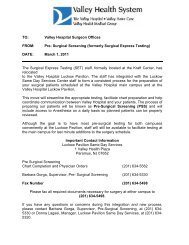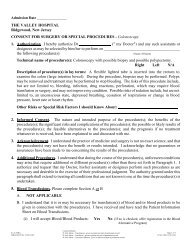Obstetrical Delivery Consent Form - Valley Hospital
Obstetrical Delivery Consent Form - Valley Hospital
Obstetrical Delivery Consent Form - Valley Hospital
Create successful ePaper yourself
Turn your PDF publications into a flip-book with our unique Google optimized e-Paper software.
(b) Local Anesthetic Agents-are injected in the skin of the region of the episiotomy to provide anestheticfor the episiotomy or the repair.(c) Other Narcotics & Barbiturates-used during early labor to decrease the pain and anxiety associatedwith labor. The complications may include pain at the injection site, low blood pressure anddepression or drowsiness of the baby if it is delivered soon after administration of the medication.7. AMNIOINFUSION-used to replace fluids into the uterus for the treatment of certain fetal heart patternsand/or meconium stained amniotic fluid. The fluid is replaced through an Internal Maternal Contractionmonitor.8. FETAL SCALP SAMPLING-used to obtain a blood specimen from the fetus to determine the fetal pH,which is a measurement of fetal well-being. The sample is obtained by inserting an instrument throughthe mothers' vagina, making a small puncture in the fetal scalp and withdrawing a small amount of bloodthrough a narrow tube. The most common complications include bleeding and superficial infection at thesite of the puncture.9. INDUCTION OF LABOR-use of techniques and/or medicines that cause the cervix to thin (efface) anddilate and stimulate labor when delivery of the fetus is indicated for medical and/or obstetrical reasons.One common example is the use of prostaglandins in the vagina to soften the cervix.10. FORCEPS DELIVERY-used to facilitate delivery in the case of prolonged labor or fetal distress. Themost common complication of forceps delivery is a mark on the baby which is usually temporary.Occasionally, abnormal maternal bleeding (hemorrhage), vaginal lacerations which may require bloodtransfusions and extensive vaginal repair, and formation of a blood collection (hematoma), may occur.11. VACUUM EXTRACTION-a device, using a suction cup attached to the fetal head, for facilitatingdelivery. The most common risks associated with this procedure include swelling, a superficial mark or abruise (hematoma) on the baby's scalp.12. CESAREAN SECTION-removal of the fetus, under anesthesia, by means of an incision into the uterusin circumstances where vaginal delivery is not possible. The most common complications include thepossibility of abnormal bleeding (hemorrhage), formation of scar tissue, and the possibility of futurecesarean section deliveries. Rarely, a complication may jeopardize the life of the mother. There is nomedically acceptable alternative to a recommended Cesarean Section. An attempted vaginal birth mayjeopardize the lift of the mother or the child.IC-42 MRec Page 4 of 704/02. 02/06
















